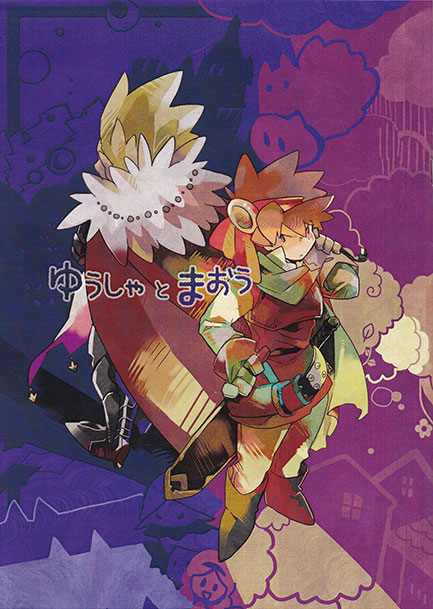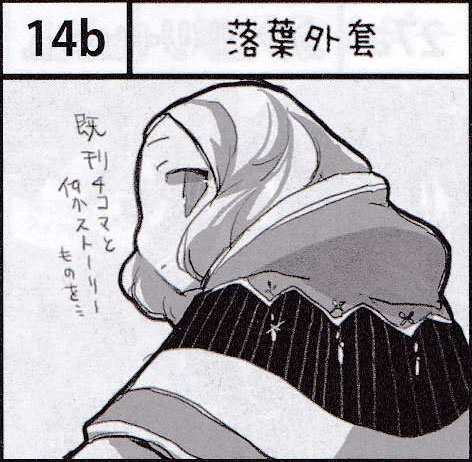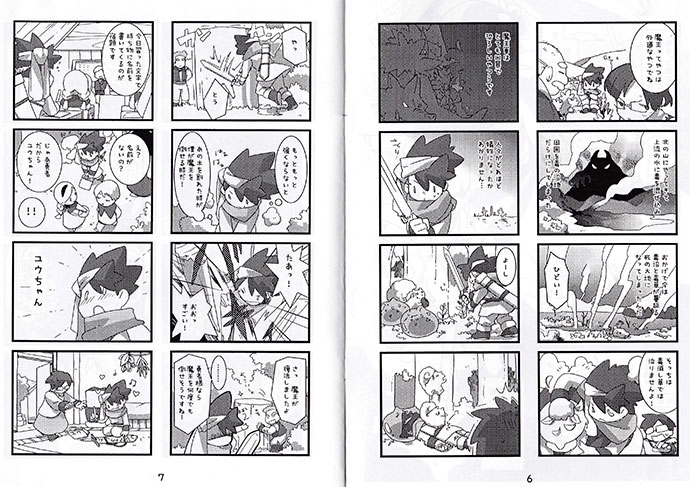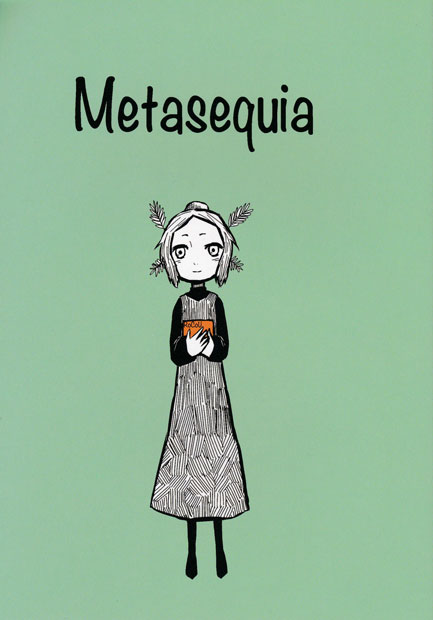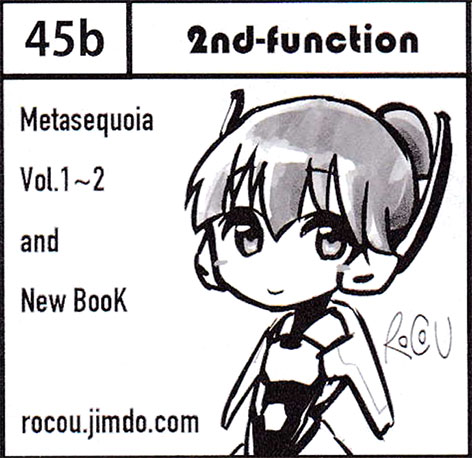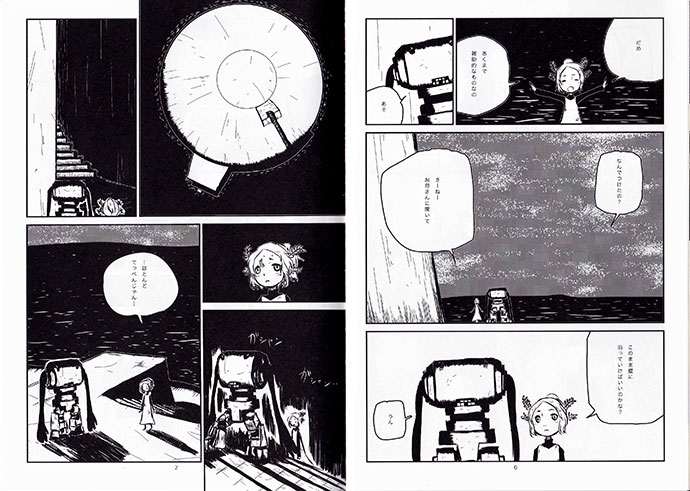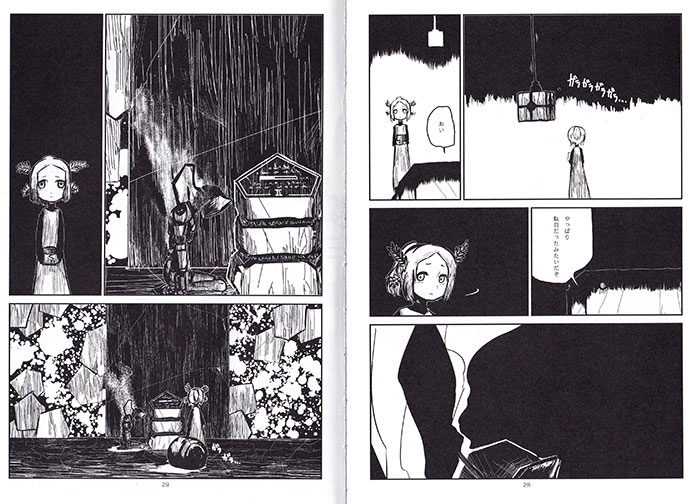Happy New Year!
I just realized I haven’t done a doujinshi review post in about 2 months. Life has been busy, but as I wrote in my previous post, I did attend Comitia 110 in November, and as always I got a few really nice books which I would like to share with you.
The below books were purchased at Comitia 110.
1 Yuusha to Maou by Nano Atsumi (circle: Ochiba Gaitou)
Comitia 110 Circle thumbnail:
Yuusha to Maou is Nano’s take on the popular theme (some might say trope) of a “chosen” hero, born to rid the world of evil. The hero of the story, latest in a line of individuals tasked with vanquishing the demon king the gods failed to in ancient times, grows up in a village among humans, who pamper him because of his status, but treat him as a distinctly different being, not even giving him a proper name (instead simply refering to him as “Yuusha,” literally meaning”hero”).
The hero grows up feeling alone and an outsider, having a hard time accepting his sole purpose as the hero of legend. When he finally ventures out to fight the evil hordes under the demon king’s command, he is promptly captured and imprisoned in the dark lord’s castle.
Once in the castle, the hero finds that while he is being experimented on leisurely by the demon king’s super-adorable evil scientist underlings, the evil forces make no serious attempt at killing him. Rather, the dark lord seems to simply be sizing him up, even deliberately creating opportunities to just talk, while of course making sure to mention as often as possible how despicable and weak human beings are.
Slowly, the hero notices that the demon king’s heart isn’t completely in the fight, and, just like himself, lacks a sense of purpose in life. Finally, he notices that everyone keeps referring to the evil one simply as “demon king,” just like himself growing up being referred to as “hero.” Maybe hero and demon king aren’t so different after all?
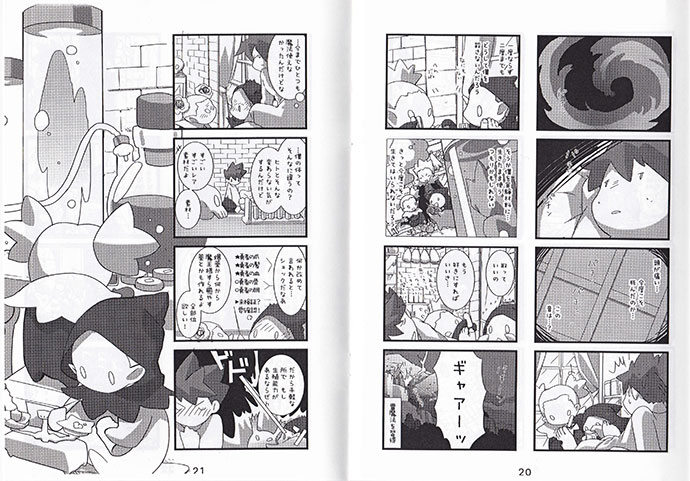 Yuusha to Maou is a simple, self-contained (albeit open ended) tale, illustrated in a beautiful style reminiscent of Disgaea or Taira Akitsu’s work. The artist used a traditional 4-panel layout, but the story is told as one and not a series of 4-panel ones.
Yuusha to Maou is a simple, self-contained (albeit open ended) tale, illustrated in a beautiful style reminiscent of Disgaea or Taira Akitsu’s work. The artist used a traditional 4-panel layout, but the story is told as one and not a series of 4-panel ones.
In a way, I feel like the layout limited the book somewhat, as sometimes the panels are too small to tell exactly what is going on. Similarly, sometimes it feels like there should be a “punchline” to a certain story bit, but it falls flat, possibly also because of the 4-panel layout, which is traditionally associated with more comical books.
Yuusha to Maou is a “copy book,” which is the simplest form of doujinshi, a bunch of copies or printouts stapled together. The book is 28 pages including 4-color covers, with b/w interiors.
I am curious about why the artist went for a copybook instead of having it printed, but at the end of the day it’s about the contents, and Yuusha to Maou is a charming little book that is accessible and fun to read.
The artist: Nano Atsumi on the web
2 Metasequoia by Rocou (circle: 2nd-function)
Comitia 110 Circle thumbnail:
On a pitch black sea, a gir is sailing towards an abandoned research facility, all the while conversing with a derelict robot. Humans are long extinct, and the two – the robot being the preserved mind of a scientist, while her nature isn’t explained in detail – are the only lifeforms to be seen.
We find out that the reason for their voyage is a search for food, since the girl has finally run out after being confined to her home for as long as she can remember. The robot points out the leaves protruding from her hair, but she explains that they are only capable of generating auxiliary energy reserves.
The two enter the facility via an access elevator on the roof – demolishing the robot’s body in the process – leaving the girl to drag the barrel-shaped head part with her into the dark halls (“It’s ok – I designed the head to be light!”).
After a long walk, and endless bitching and moaning from the robot head (“I never should’ve wasted all that money on the brain preservation procedure..”) they reach a control center, where a derelict service android summons a food package, before bursting into flames.
Metasequoia is the first book of a series, kind of a rare thing for doujinshi. As you can tell from the synopsis above, the story moves at a leisurely pace, without action pieces or a real resolution, but offers a lot of introspection about life in its (very very) post-apocalyptic world.
The book’s appeal lies in the witty dialogue between the pure-minded and optimistic girl, and the desolate and snarky robot. This contrast between the characters’ personalities creates an interesting dynamic that kept me intrigued through the book.
The artwork, a bit simplistic with lots of spot blacks and whites, and fairly rough brush strokes, sets the stage for it but doesn’t steal its attention. I am, however, quite partial to the storytelling when the service android collapses.
Metasequoia is A5, 32 story pages, and leaves the reader with more questions about its world than it answers. Good thing there’s a sequel!
The artist: Rocou on the web, Twitter. More samples from the Metasequoia series can be found at: http://mtsq.jimdo.com/
That’s it for today! Hope you enjoyed the read.
In for more? Make sure to check the doujinshi tag for books I have previously reviewed.
As always, I welcome feedback and interaction, so I’d be happy if you liked/reblogged, or even commented. Questions and suggestions are welcome!
